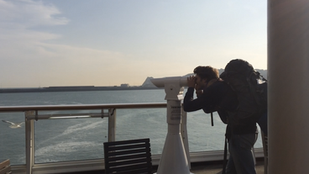Festival De La Cultura Wayuu
- Noah Joubert
- Jun 20, 2015
- 4 min read

I had been waiting for this since the first day of work with the TV show, a festival about an indigenous culture here in the Caribbean coast of Colombia. It was going to take place in the indigenous capital of Colombia, Uribia. This town, its surrounding area and the bordering areas of Venezuela is mainly inhabited by an indigenous group called the Wayuu. They are particularly famous for the beautiful art the women make. Using beautiful patterns and colors they sow the most amazing bags I have ever seen. Besides their art was fascinated me even more was the culture. They had never been subjugated by the Spanish invaders and due to them not allowing a lot of other influences to penetrate their culture they have managed to maintain and honor it in basically the same way for hundreds of years. They speak their own language: wayuunaiki – people of the tribe that can’t speak it are even ridiculed. Another thing that I learnt and found very mentionable is the ritual that young teenage girls go through once their menstruation starts.
The mother and grandmother will cut her hair, which had never been cut before, very short. She is not allowed to leave the house for many months and sometimes years. During that time she is washed regularly and taught how to behave as a woman of the wayuu by her elders. I have found that they don’t seem to talk a lot, the men seem to be doing most of the talking and decision making. Or so it seems, during a conversation with a wayuu he told me that actually in this culture the women are the decision makers. It is a matriarchal community. One example of this would be that the children are always the children of the mother, in the sense of the mother’s clan name being the one carried on by the children.
During the first morning of the festival a ritual takes place, lead by one of the shaman woman from a wayuu clan. We arrive with the cameras at the little wooden hut in front of which she had laid out a blanket. On this blanket she had placed a couple of seeds, fruit, stones and other things she would be using during the ritual. Before the sunrise she begins. She hums and speaks words in wayuunaiki to the representative woman from each clan. More and more people in their traditional wear join to watch the ritual. Now she takes a flask to her lips and a few seconds later sprays the liquid over the blanket, I am guessing it was a form of blessing. She continues with this blessing in regular intervals, in between which she sings and hums more prayers for the clans of the wayuu. As the ritual comes to an end the first sunrays hit the hard earthen ground, now the people start walking and drums start being played for a march leading to the town’s center.
There we arrive and I see the dozens of stands behind which women sell their artwork. Incredibly beautiful patterns and colours are used in wristbands, blankets, hammocks and mochilas (a kind of shoulder bag). These handcrafted designs line the plaza of the town in long rows. A truly stunning display of the artisan works of the wayuu.
During the following days we get to see many traditional dances, where they imitate the movements of birds; bow competitions; other traditional games; wrestling and traditional musical instruments.
On the last day of the festival we attend a horserace a little outside of the town. The dusty ground, the wind and large open ground make for a deadly combination. Just during the first few minutes I feel my body being coated with fine grains. The people with the most problems were actually the film crew; their cameras and microphones don’t like being covered in sand very much. The races start with stunts from a crew that had come from the distant Cordoba. The first two race by on their horses at an incredible speed, now one of them stands up and waves to the people in the crowd. The next two both stand on their horses as they gallop passed us. Now the third group consisted of three horses – with a hammock strung in between the three horses. Each horse had one rider and in between each horse sat another person in the hammock. Now for the fourth group they came to me.
“Come, we’ll make you part of the show.” The say as they grab me and take me to two horses in between which they had strung a hammock.
“You lie in there, make sure to keep the sides of the hammock closed above your head and keep your body stiff like a board – then you should be fine.” One of the men says from atop his horse. With the encouragement of the film crew I climb into the open hammock. However as soon as my body enters the cloth one of the horses gets pulled to the side.
“Ah shit, looks like you’re too heavy man. It must be that big hair of yours.” One of the riders says laughing at me. The others join in and another, smaller man jumps in instead of me. To be quite honest I am not sure if I should be happy or unhappy about being to heavy for the hammock. But after seeing the speed at which they carried the hammock over the road, and how close the hammock got to touching the hard ground – I must say I was very relieved that they decided to opt for a lighter person. As I would have almost definitely been dragged over the terrain and it would have been a rather sad ending for the german ‘Greengo’.








Comments